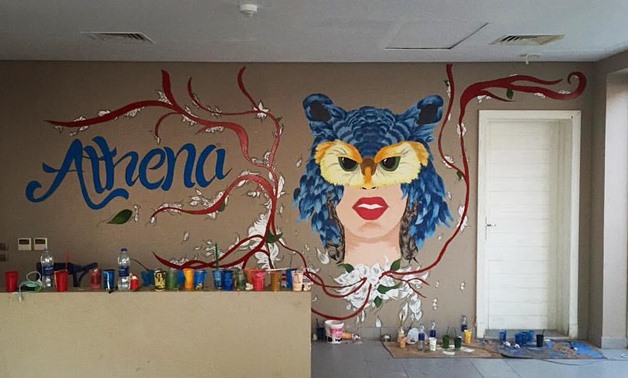
Artwork courtesy Donia Nagy
Meet Donia Nagy, a second-year student at the German University in Cairo’s Faculty of Applied Arts. The 19-year-old is honing her skills in photography, drawing and graphic design and plans to specialize in media design, which she believes can be a powerful tool to advocate for women.
What inspires your work?
I’m always inspired by the problems I’m facing or the issues of equality and humanity. Also, I find inspiration in movies and novels—I see how women are depicted with contempt within them and I try to reflect this in my work.
How has your work developed over the years?
At first, when I developed my love for art I drew a lot without knowing how or why my work could affect anyone. Then, I began to discover the real propose of art and design—the way I like to see it is how art or design can affect generations. So I started sending messages in my work, trying not to force it into people’s minds but making them feel it. I developed my techniques by taking people’s criticisms into consideration and learning from my mistakes, and I think that that’s the way to succeed.
What do you like most about your work?
I like the feeling I have when I’m finished with it. I’m really bad at conveying my feelings and thoughts through words and since I was a child, I used art to express them. My work gives me the space to address major problems and show how I’ve been touched by them.
How do you see the art scene in Egypt?
I see failure across the board when it comes to supporting art in Egypt, a bare minimum appreciation of designers. Art is the most important part of people’s lives—the films they are watching is art, the clothes they are wearing is art, the posters they’re admiring is art, paintings hanging on every wall in their house is art. But then along comes one parent telling his son or daughter to go study engineering so they can have a brighter future—well, there’s nothing brighter than art. I don’t think graphic is appreciated in Egypt even though we have amazingly talented graphic designers.

Artwork courtesy Donia Nagy
What’s it like for young artists trying to break to the scene in Egypt? What are the obstacles you’re facing?
As I said, there is very limited support for art and development. I always try to get [people out of their comfort zone] and confront them with the truth of their culture and the community they are living in, the way media does when directors try to portray very realistic and unembellished truth in their work. The audience is easily shocked and offended, as for example with the series Sabe’ Gar (Seventh Neighbor) which was criticized for the negative behavior of the characters and the director allegedly bringing up ‘such lies’ even though they are only expressing the truth of what people are dealing with. People have to accept different perspectives of art as they’re not living in our bodies nor do they know what we’re going through.
Who are your favorite artists? Why?
Locally, Batool Al Daawi is one of my favorite photographers; she’s so talented and successful even though the industry that she is working in is largely perceived in Egypt as a man’s job, that it needs a man to ‘handle it.’ I’m totally against this concept. She’s getting orders from all sorts of media in Egypt and is being contracted for many projects, from the song “Talat Dakat” (Three Beats), the Orange World Cup ad, Vodafone’s Ramadan 2017 ad as well as the one for Pure juice starring Dorra. She’s also worked for TV on Al Gamaa’ (The Brotherhood), Al Kabreet al-Ahmar (The Red Matchstick) and the movie Bashtery Ragel (I’m Paying for a Man), among many others.
Amr Salama is one of my favorite filmmakers; he is unlike other directors because he really knows how to depict real life through his movies, sending people messages through his work without forcing them onto his viewers.
Internationally, Frida Kahlo was one of my favorite painters, I admire the way she saw things and the way she expressed her pain with surrealism.
What messages do you want to send through your art? Tell us a little bit about your most recent project with Mostafa Mohsen and Amr Allam.
I mostly send indirect messages to support women’s rights, I’m still not professional enough to ensure I’m making strong statements, but I’m working to improve my projects.
One of my favorite experiences was a recent project in the North Coast where a client commissioned me, Mostafa Mohsen and Amr Allam to work on her Greek-themed restaurant named Athena. To come up with a concept, we researched Greek culture and the goddess Athena. She was associated with large cats so we visualized Athena with a puma’s head and for color we used wallpaint and black permanent markers.
What are your plans for the future?
I’ll continue with my projects and work on improving my techniques. I plan to specialize in media and work on my filmmaking skills so I can produce real projects that send important messages to people; messages that would change the world and the way people have contempt for humanity. All my life, I knew that my passion for art would make me better and benefit the world. My next project is going to be an awareness campaign about female circumcision. I hope it will help me learn and improve my skills.

Comments
Leave a Comment